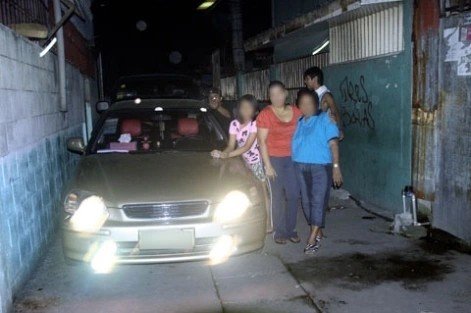Space and Time: A Note from Rocky on Blazer
SPACE AND TIME
Rocky · Follow
7 min read · Rocky’s presentation transcript in association with CENTER SANTA FE & YOUTH ALIVE! · Sept 22
Blazer is a short film made up of still photography scored with original music and sound design.
Installation view of “You and Me on a Sunny Day”
Dear Movie Lovers,
I don’t know where the drive to create Blazer came from exactly, but I did a similar story in my ciné-roman flash fiction, You and Me on a Sunny Day.
I do know that I am bringing the movie-going experience to the museum. I see my work as a fusion of the photographer, the filmmaker, and the scriptwriter.
This is a spatial dispositional drawing illustrating the scalability of my cinematic installations from 2005. This is an idea that I’ve been actively working towards for the past 18 years.
The theory of spatial and empathic perspective-taking
Being able to tune into the thoughts and feelings of our interaction partners is a main component of empathy (i.e., perspective-taking; Davis, 1983) and an important aspect of social life.
By surrounding the viewer in larger-than-life, chronological film stills, the spectator's movement through the space allows the story to reach its emotional potential.
Before I embarked on the project Blazer, I spent 5 years creating one of the world’s largest photography installations. The full volume of You and Me on a Sunny Day spans 1000+ feet of wall space. I specifically designed it to fill the entirety of the Guggenheim Museum—creating one continuous surround cinema installation.
Blazer and You and Me on a Sunny Day are one in the same, categorically considered ciné-romans. As defined by William Van Wert in The Theory and Practice of the Ciné-roman, a ciné-roman directly translates to film-novel, probably more accurately cinematographic photography or literary cinema.
Blazer, which was selected for the CENTER Social Award, is my modest attempt to stop gun violence and support families to recover with intervention, prevention, and healing programs. Please visit Youth ALIVE! in Oakland to learn how you can help or donate today.
Blazer began with a simple snapshot.
An unbelievable photograph; an extraordinary photograph; a real photograph that altered my fabric of reality.
I was moved by the complexity and stakes of an amateur’s once-in-a-lifetime photograph because it froze all six of the basic emotions at once: happiness, fear, sadness, anger, disgust, and surprise. This volume of images was meant to honor Reynaldo Dagsa, the frailty of life, and his profound photograph.
Even more profoundly, the fictional story that I fleshed out in 2018, with an autobiographical slant, grew into a direct reflection of 2020.
Let’s dive deeper into the making of Blazer.
Cambo 8x10-inch camera focused on the prop car
I purchased the Chevy Blazer prop car for $500.
Early Blazer test shot
The original actor that I worked with for Blazer was named Malik. We shot together a few times on 8x10-inch film. Due to logistical reasons, I ended up recasting everyone and starting from scratch.
My dad taking a picture of his own car in 2017
During this time, I was script writing and storyboarding Blazer, when out-of-the-blue, my dad was diagnosed with cancer. Above, he is pictured a few months before he passed.
We had just had our first girl. That’s her in the middle with my wife in Lahaina, Hawaii, and in the hospital with my dad in Ohio.
A picture that I took of my dad’s car (without him).
Photo by ©Reynaldo Dagsa, Inspiration photo for Still from Blazer #715, 2011
A symbolic illustration of me writing “Blazer”
Reynaldo Dagsa’s photograph embodied something I had never felt in art before, yet I had felt it in life before.
In the beginning, Ray represented my dad, the man who gave me my first camera, someone that was so full of life, someone that was so alive, his time cut short.
I was questioning the nature of existence.
The phenomenon of Dagsa’s photograph is, in that exact space and time, the past and future are equidistant from one another.
Installation view of “You and Me on a Sunny Day“
Lighting and location test for “Blazer”
8x10-inch Fujifilm chromes for “Blazer”
I was juggling many things: I was getting more shows forYou and Me on a Sunny Day, working a full-time day job, and continuing to shoot Blazer on the weekends with Justin King on 8x10-inch film. Yet, my ability to shoot film was coming to an end; my film developer in San Francisco and my frame shop in Alameda both went out of business. I had to accept that I needed to change to digital.
Eadweard Muybridge is known for his pioneering chronophotography.
Rocky’s chronophotography, Stills from Blazer #433–441
My wife helped me get the Fujifilm GFX100 camera for my birthday. I could finally create the fictional Muybridge imagery that I’ve been working towards.
I felt that we were pursuing an important body of work, but I had no way of really knowing that Blazer would become a direct reflection of the state of the world in 2020—mirroring life during the pandemic and the 1021 people shot to death by the police in the United States.
Black Americans are disproportionately impacted by gun violence, gun homicides, assaults, and have a higher rate of fatal police shootings in the United States.
Blazer is about the global pandemic and the local epidemic of gun violence. By creating a body of work where the audience becomes the protagonist, we were hoping to create change through perspective-taking and understanding a new point of view.
Sincerely,
Rocky
Make a donation.
Youth ALIVE! has spent 25 years educating and training young leaders, interrupting cycles of violence on the streets, and providing ongoing support to the wounded and grieving. With your help, we will continue to perform this essential, life-saving work for many years to come.
Make a tax-deductible gift today, and help us prevent violence and create young leaders!
Blazer Hardcover: Collector's Edition
LIMITED PRODUCTION BATCH OF 50 PIECES
Special collector’s edition of Rocky’s Blazer, the ciné-roman book version, is limited to 50 signed and numbered hardcover copies.
























